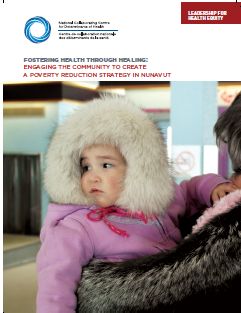Fostering health through healing: engaging the community to create a poverty reduction strategy in Nunavut
Cette ressource est aussi disponible en français.
This document is part of the 'Leadership for Health Equity' Series.
As a part of our Public Health leadership initiative, the NCCDH produced a series of case studies profiling instances of leadership to advance health equity in Canada. These documents are learning tools; they are designed to help Public Health staff reflect on the qualities of effective leadership in advancing health equity, as well as on the strategies and conditions that develop and support these qualities in Public Health leaders at all levels.
Income is a widely recognized social determinant of health. To the Inuit of Nunavut (Nunavummiut), physical and mental health cannot be separated, and the relationship between poverty and physical and mental illness is circular, with each one building on the others.
This case study looks at Nunavut’s shared leadership approach to developing a poverty reduction strategy. It discusses why healing from the wounds inflicted by colonialism is an integral part of The Makimaniq Plan: A Shared Approach to Poverty Reduction. In Inuktitut, Makimaniq means “empowerment” or “standing up for yourself.” The strategy grew out of intense collaboration between government and Inuit organizations, and public and non-governmental organizations, and resulted in the Collaboration for Poverty Reduction Act, in 2013.
The case gives historical background, discusses what poverty means in Nunavut, and describes the four stages of the public engagement process:
- community dialogues on poverty reduction (winter 2011)
- regional roundtables for poverty reduction (May to June 2011)
- poverty summit (November 2011)
- program delivery (ongoing)
The case study concludes with how the community worked with challenges, and the successes and strengths of their approach.
Use this resource to
- learn about the Nunavummiut concept of health
- consider indicators that best reveal the issues related to poverty
- build a collaborative approach to poverty reduction
- reflect on how cultural beliefs affect poverty reduction and health equity work
More from this series:
- Public health leadership to advance health equity: A review summary
- Public health leadership for action on health equity: A literature review
- Case Study: Leadership for health equity: Working intersectorally and engaging the community in Western Health (2014)
- Case Study: Alberta Health Services: Establishing a province-wide social determinants of health and health equity approach (2013)
- Case Study: Making the case for health equity: Winnipeg’s experience (2012)
- Case Study: Improving health equity in Saskatoon: From data to action (2012)
- Case Study: Empower the community: New Brunswick’s approach to overcoming poverty (2012)
- Case Study: Capitalizing on change: Building leadership competency in public health in Quebec (2012)
Reference
National Collaborating Centre for Determinants of Health. (2014). Fostering health through healing: Engaging the community to create a poverty reduction strategy in Nunavut. Antigonish, NS: National Collaborating Centre for Determinants of Health, St. Francis Xavier University.
Tags: Community engagement, Indigenous health, Leadership & capacity building, Document, Case Study, Leadership for Health Equity
